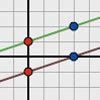Skip over navigation


Or search by topic
Number and algebra
Geometry and measure
Probability and statistics
Working mathematically
Advanced mathematics
For younger learners
Enclosing Squares
Age 11 to 14
Challenge Level 





- Problem
- Getting Started
- Student Solutions
- Teachers' Resources
Between two points find out how muchyou go across and
how much you go up.
From these two distances you can find the gradient and the length of the line segment between the points.
From these two distances you can find the gradient and the length of the line segment between the points.
You may also like
Parallel Lines
How does the position of the line affect the equation of the line? What can you say about the equations of parallel lines?
Reflecting Lines
Investigate what happens to the equations of different lines when you reflect them in one of the axes. Try to predict what will happen. Explain your findings.

